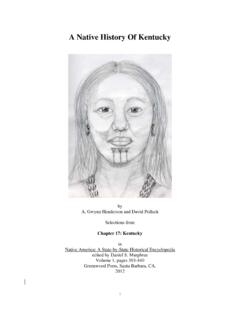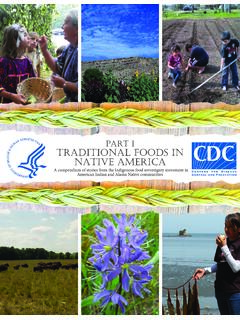Transcription of Gardening with Oregon Native Plants - NPSOregon.org
1 Gardening WITHOREGON Native PLANTSWEST OF THE CASCADESEC 1577 Reprinted March 2008 CONTENTSB enefi ts of growing Native Plants .. 1 Plant selection .. 2 Establishment and care .. 3 Plant combinations .. 5 Resources .. 5 Recommended Native Plants for home gardens in western Oregon .. 8 Trees .. 9 Shrubs .. 12 Groundcovers .. 19 Herbaceous perennials and ferns .. 21 Annuals .. 29 Prepared by Linda McMahan, Extension horticulture faculty, Yamhill County, Oregon State credits: The photo of Iris tenax is used courtesy of Neil Bell, Oregon State University. The photos of Clarka amoena and Heuchera micrantha are used courtesy of Br. Alfred Brousseau, Saint Mary s College. Photos of the following Plants are from the OSU Landscape Plants website, courtesy of Pat Breen ( ): Alnus rubra, Rhamnus purshiana, Thuja plicata, Prunus emarginata, Pseudotsuga menziesii, Arbutus menziesii, Quercus garryana, Pinus ponderosa, Ceanothus thyrsifl orus, Sambucus racemosa, Vaccinium ovatum, Vaccinium parvifolium, Acrtostaphylos columbiana, Holodiscus discolor, Berberis nervosa, Berberis aquifolium, Rhododendron macrophyllum, Gaultheria shallon, Garrya elliptica, Spiraea douglasii, Arctostaphylos urva-ursi, Oxalis oregana.
2 All other photos are from the more Gardening information and publications, visit the OSU Extension Service website at publication provides an introduction and guide for those who are interested in Pacifi c Northwest Native Plants and would like to incor-porate natives into their home gardens. Included are: Basic information about selection, establish-ment, and care A list of recommended Pacifi c Northwest Native Plants ; the plant list focuses on Plants that are relatively easy to acquire, establish, and grow. Exceptions or special requirements are noted. A list of other resources A wide variety of Native Plants , from trees to fl owering shrubs, herbaceous perennials, ferns, annuals, and groundcovers, are available for home gardens. In this publication, Native Plants are considered to be those found natu-rally at the time of European settlement ( Cullina 2002) in western Oregon , from the Cascade Mountains to the coast.
3 Some Native Plants have natural ranges that extend south into California or north to Wash-ington and Canada. A very few, , yarrow (Achillea millefolium), have ranges that extend across the or even to Europe. Although this publication provides some basic plant choices, the Resources section includes many outstanding references, including Krucke-berg (1996), Pettinger and Costanzo (2002), and Cullina (2000, 2002). These books provide specifi c information about appropriate garden conditions and care for each kind of plant. More experienced Native plant gardeners might wish to seek additional information in other books and references available from libraries or booksellers, as well as websites. To see photos of regional gardens featuring Native Plants , refer to Johnson (1998).BENEFITS OF GROWING Native PLANTSP acifi c Northwest Native Plants grow under a wide range of Gardening conditions.
4 Some are good accent Plants ; others are groundcovers. Many Native Plants tolerate summer drought (Kruckeberg 1996, Bell et al. 2001, and Pettinger and Costanzo 2002). All are adapted to local gar-den soils in their places of origin (Pettinger and Costanzo 2002). Adapted to local soils and weatherNative Plants have grown in our region for thousands of years. They are adapted to our regional climate wet winters and dry summers (Kruckeberg 1996). However, most Native Plants benefi t from regular irrigation, especially during establishment. Keep in mind that some Native Gardening WITH Oregon Native Plants WEST OF THE CASCADES By Linda R. McMahan2plants are from moist woodland or wetland habi-tats where drought tolerance has not Native Plants are well adapted to the soils often found in gardens west of the Cascades (Kruckeberg 1996). Do not assume, however, that all Pacifi c Northwest soils are alike, even in nature.
5 Furthermore, garden soil often is not Native soil, since it may have been altered during construction and by Gardening (Pettinger and Costanzo 2002). In short, garden soil types and climates vary greatly, so a particular Native plant may or may not be appropriate for the conditions or micro-climates in your garden. As is the case in garden-ing in general, choosing the right plant for the right place is very important for valueNative Plants provide habitat for birds, small animals, amphibians, reptiles, and insects. This habitat is important for feeding, reproduc-tion, and protection from the sun, wind, and predators. Flowering shrubs, trees, and herbaceous Plants provide nectar for many types of insects and for hummingbirds. Seeds and berries nur-ture birds and other wildlife. Shrubs and trees provide nesting sites for birds, squirrels, and other creatures. Other Plants serve as hosts (food sources) for the caterpillar stages of Native but-terfl ies, or as nectar sources for adult butterfl ies or other insects.
6 For more information, refer to the plant list and consult the references listed under Gardening for Wildlife and Butterfl y Host Plants in Resources. Noninvasive in wild habitatsFinally, Pacifi c Northwest Native Plants are already established in balanced, local ecosys-tems, so they have little or no potential to become invasive pests in our wild and natural areas. However, some natives can be aggressive in garden settings. Some Native Plants spread underground, such as Oregon grape (Berberis aquifolium), red-twig dogwood (Cornus seri-cea), or wild bleeding heart (Dicentra formosa). Others readily self seed, , California poppy (Eschscholzia californica) and Douglas aster (Aster subspicatus). Keep these characteristics in mind when planting these SELECTIONS electing Native Plants for your home land-scape is essentially the same process you would use for selecting any garden plant.
7 Matching your desired plant list with the conditions already existing or easily created in your own garden will help ensure success (Pettinger and Costanzo 2002). 1. Determine the kinds of Plants you are look-ing for. Consider your wishes and needs for trees, shrubs, herbaceous perennials, and groundcovers. List your favorite garden colors. Decide whether you want decidu-ous or evergreen trees and shrubs. Consider whether you are creating a new garden, such as a woodland garden, or adding Native Plants to an established garden. If one of your goals is to attract wildlife, choose Plants to support this goal. Consider whether drought tolerance is important. 2. Examine your garden conditions. Determine whether your site is sunny, has part sun or shade, or is shady. Check the condition of the soil. Within your garden, you may have many different kinds of conditions; try to match your desired Plants to individual places in your landscape.
8 33. Determine appropriate Plants . Look through the list of Plants in this publication to fi nd those that might suit your purposes. To learn more about individual Plants or to fi nd additional choices, use the references and websites listed under Resources. Make sure each plant s require-ments match your garden conditions. Find pictures of the Plants to help you understand how they fi t into your garden preferences. An excellent source of photographs for most of the trees and shrubs listed in this publication is a website developed for horticulture students at Oregon State University ( ). Pojar and Mackinnon (1994) and Brenzel (2001) are excellent refer-ences with photographs. Plant breeders have developed cultivars (vari-eties) of many Pacifi c Northwest Native Plants . Cultivars offer specifi c plant characteristics, such as fl ower color or plant size. A note in the plant descriptions will identify species for which cultivars might be available.
9 However, new cultivars continue to be developed, so the notes will not be complete. If you want spe-cifi c cultivars or varied color forms, consult the references. In some cases, species Native to Oregon are widespread in other areas as well. Different forms of these species are Native in different areas, so a particular form might not be Native to Oregon . For example, kinnikinnick (Arcto-staphylos uva-ursi) is Native to many regions of the United States. Other widespread species include red-twig dogwood (Cornus sericea), Oregon sunshine (Eriophyllum lanatum), Douglas-fi r (Pseudotsuga menziesii), and ponderosa pine (Pinus ponderosa). If you wish to use local forms, you will need to know the origin of cultivars or Plants you choose. Plant sellers often have this information. In the case of ponderosa pine, it is particularly important to use locally adapted Plants , such as the Willamette Valley form.
10 These forms will perform better in the wetter soils found west of the Cascade Mountains than will forms Native to the east side. 4. Look for sources. Many nurseries stock Native Plants . Once you know what Plants you are looking for, make a list and carry it with you when you visit nurseries. Some retail nurser-ies have Native plant sections; others intermix Native Plants with those of other origins. A few nurseries specialize in Native Plants . Find sources for Native Plants through direc-tories provided by the Oregon Association of Nurseries (listed in Finding Plants in Resources, through web searches, or by contacting your local OSU Extension offi ce for recommendations). You may wish to propagate your own Plants . Many Native Plants can be propagated from either seeds or cuttings. For more informa-tion, consult resources such as Rose et al. (1998) and Cullina (2000, 2002).





